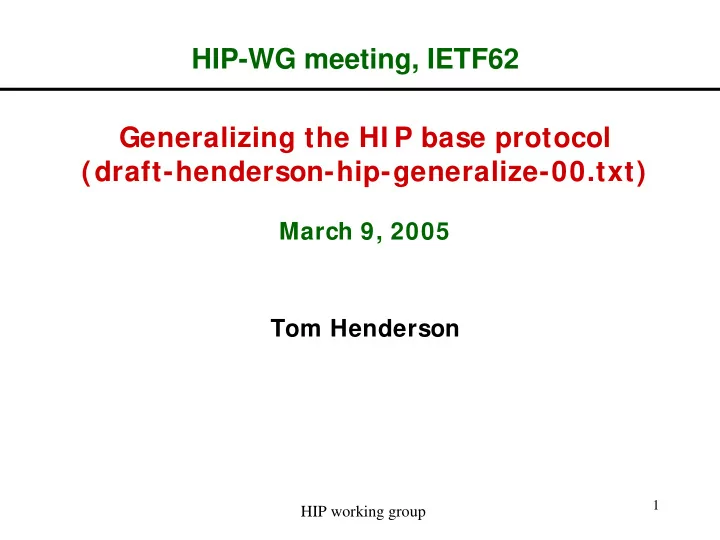

HIP-WG meeting, IETF62 Generalizing the HI P base protocol (draft-henderson-hip-generalize-00.txt) March 9, 2005 Tom Henderson 1 HIP working group
Executive summary • A few small changes to the base protocol now may give us more room to experiment in the future 1. Generalize HIT fields to “upper layer identifier (ULID)” 2. Allow multiple usage profiles for HIP handshake 3. Do not mandate that specific HIP messages carry specific parameters 2 HIP working group
Motivation • Should we be allowing for more experimentation in the use of HIP protocols? – HIP protocols perceived to be too inflexible by some – Find the common ground between a number of similar proposals, and see how HIP fits shim6 HIP NIMROD mobile IP i3 IPNL TRIAD FARA DataRouter SIM Network Pointers MAST/CELP DOA Hi3 WIMP SCTP MOBIKE 3 HIP working group
Generalized architecture Transport protocols IP endpoint sub-layer Dest. options AH ESP Frag/reass shim layer IP routing sub-layer IP Figure adapted from: E. Nordmark and M. Bagnulo, “Multihoming L3 Shim Approach,” draft-ietf-multi6-l3shim-00, January 2005 4 HIP working group
Decomposition 1. Upper-layer identifier: HIT, but also mobile IP home address, unique-local address, identifier-address, and other identifiers at other layers (e.g., session) 2. Address resolution: “Early binding” (HIP) or “late binding” (e.g., i3, mobile IP through home agent) 3. Context establishment: HIP handshake, but also IKE/MOBIKE and shim6 4. Per-packet context: SPI, but also Routing Headers/Destination Options, or explicit shim headers 5. Locator management: HIP mobility/multihoming, but also MAST, CELP, multi6 locator selection, hash-based addresses 5 HIP working group
Combinations • HIP/i3 (Hi3) • HIP/IKE (or MOBIKE) • HIP/mobile IP • HIP/multi6 • HIP rendezvous server and STUN Would a generalized protocol make these combinations easier? 6 HIP working group
Proposal 1. I dentifiers • Allow use of non-HIT identifiers (or non-128 bit identifiers) – Used as ULIDs in transport protocol – Pekka has suggested a few standard sizes rather than TLV format (e.g. 32, 64, 128, 256, 512) • Benefits: – Future evolutions in HITs (e.g., current SHA-1 concerns) – More flexibility in invoking HIP handshake • What if context establishment is deferred, and IP addresses used in transport sockets? 7 HIP working group
Proposal 2. Handshake types • Allow use of handshake variants – Existing handshake would be one usage profile • SIGMA-compliant DH key exchange – Perhaps indicated as different flavors of I1, or a type parameter • Benefits – Allowing lighter-weight handshakes such as WIMP (based on hash chains) 8 HIP working group
Proposal 3. Mandatory parameters • Do not mandate that packet types carry mandatory parameters – Only mandatory parameters are the identifiers (was the HITs) – Handshake type defines the usage profile (requirements) on later messages – e.g. if I1 indicates current HIP usage profile, then R1 MUST include PUZZLE • Corollary: avoid making statements such as ESP is a “MUST” implement • This mainly affects how draft is organized and written 9 HIP working group
Security considerations • Mixing and matching of protocol elements obviously changes the security properties – Leave this for other drafts • May offer a more gradual path forward to a HIP-enabled world (with better security) 10 HIP working group
Summary • Current HIP could be defined as a “usage profile” of a slightly more generalized protocol • Possible benefits: – HIP elements could be considered for the shim6 protocol – HIP messaging may be able to secure mobile IPv6 Binding Update – Might allow other identifier types while still enabling the ID/locator separation 11 HIP working group
Recommend
More recommend